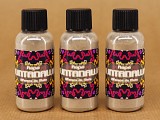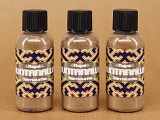Bottle, 10 Ml, 7 Gr from Brazil (SKU 3105)
(Batch #2610). Flor de Jarina Rapé is a celebrated blend from the Kuntanawa tribe, recognised for its unique combination of Moi Tabaco (Fumo de Rolo), Jarina flowers, and Xixá ashes. This blend is particularly valued for its protective qualities. The Kuntanawa believe that the Jarina flowers help make the user invisible to enemies and shield them from harmful energies, both physical and spiritual. The initial strong effect is followed by lasting aftereffects that can continue for several minutes. Users typically experience minimal purging, with most effects concentrated around the head. This Rapé is best used in a comfortable setting as it takes a moment to regain stability after use. More information can be read below.
Packed in 10 ml clear plastic bottles containing 7 gr.
After a year of absence, this exquisite Rapé is finally back in stock! Highly praised by regular customers, this special Rapé comes from one of our most trusted sources.
Flor de Jarina Rapé is a celebrated blend from the Kuntanawa tribe, known for its unique combination of Moi Tabaco (Fumo de Rolo), Jarina flowers, and Xixá ashes. This blend is particularly valued for its protective qualities. The Kuntanawa believe that the Jarina flowers help make the user invisible to enemies and shield them from harmful energies, both physical and spiritual. The flowers create a protective field around the user. This powerful Rapé delivers a calming wave that starts from the head and moves down, grounding the user into the lower body, and into the earth. The spirit of Jarina promotes a sense of safety, balance, harmony, alignment, strength, and peace within the heart.
Flor de Jarina Rapé is an extremely fine powder with its distinct color variation. It is powerful and sometimes overwhelming, offering strong forest flower flavors. Even in low doses, the Rapé widens the nostrils and, with a larger dose, causes the eyes to water instantly. The initial strong effect is followed by lasting aftereffects that can continue for several minutes. Users typically experience minimal purging, with most initial effects concentrated around the head. Slowly, the user incarnates back into the body, experiencing a comforting and grounding closure. As with most Rapé's it is best used in a comfortable setting as it takes a moment to regain stability after use.
Flor de Jarina refers to the flowers of Phytelephas macrocarpa, also known as vegetable Ivory, Tagua, Nut Palm, and Ivory Nut Palm. This evergreen tree grows slowly to about 3.5 meters tall and 3 meters wide and is found in South America, particularly in Brazil, Bolivia, and Peru. The seeds, known for their hardness and ivory-like quality, are used in making buttons, chess pieces, and other items. The leaves are used for making baskets and thatching, while the plant fibers are used for brooms, torches, and fire starters. The immature fruit's seed tissue is liquid and consumed as a refreshing, sweet-flavored drink, and the fruit itself is used as a coffee substitute.
The Tabaco used in Flor de Jarina is exclusively Tabaco de Moi. The ashes are from a tree called Xixá. The Jarina flower is notable in regional mythology, appearing in various tribes' stories and being an ingredient in several Ayahuasca brews. It is the most fragrant flower of the forest, with a scent that can be detected from many meters away, attracting numerous types of insects, particularly bees—up to 15 different species can be observed on a single flower.
The Kuntanawa tribe uses Flor de Jarina Rapé for its profound spiritual and physical benefits. The protective properties of the Jarina flowers are integral to their rituals and daily practices, providing a sense of security and enhancing spiritual connection. This Rapé is particularly effective in creating mental clarity and emotional balance, making it a valuable tool for meditation and spiritual practices.
We take great care to reprocess all received stock to ensure the finest quality powder. Often, Rapé arrives with varying levels of fineness due to the lack of professional sieves used by the tribe. To address this, we meticulously sieve all powders to remove rough bits and particles, resulting in an exceptionally smooth and effective powder at 150-micron fineness. We use laboratory-grade sieves and dehydrating equipment to achieve this quality. This is our standard because it provides the best Rapé experience.
Like the Nukini, the Kuntanawa tribe became almost extinct due to the massacres of the latex cycle. One single family was left after the rubber boom and only since the beginning in 2000 a small group of Kuntanawa started to claim their indigenous heritage (Pantoja et al. 2014; Labate et al. 2014). Unfortunately, their culture is still under threat and the Kuntanawa are still struggling to regain full ethnic recognition and they are trying to regain their territory. Nowadays, there are only about 250 members left that are scattered throughout the region of Acre, Brazil. In order to survive, the Kuntanawa are joining other Pano linguistic tribes and they are organizing festivals together to share their traditions, their rituals, and their culture with foreign visitors. This small Pano linguistic tribe strongly values the ritualistic use of Ayahuasca to teach them and to guide them. The Kuntanwa even hold a strong believe that Ayahuasca will unravel their ancient knowledge and bring back their partly lost traditions (Pantoja et al. 2014). However, their language seems to be irrecoverably lost (Labate et al. 2014).
Pantoja CM, Meyer M. Kuntanawa: Ayahuasca, Ethnicity, and Culture. From the book: Ayahuasca Shamanism in the Amazon and Beyond. Oxford University Press, 2014.
Labate BC, Coutinho T (2014). My Grandfather Served Ayahuasca to Mestre Irineu: Reflections on the Entrance of Indigenous Peoples into the Urban Circuit of Ayahuasca Consumption in Brazil. Curare – Journal of Medical Anthropology, vol 3
https://pfaf.org/User/Plant.aspx?LatinName=Phytelephas+macrocarpa
This item is not allowed in the following countries:
Finland
This natural product is offered for its ethnographic and historical value and is delivered with no expressed or implied fitness for a specific purpose. It is simply a raw botanical specimen, or a scientific sample. The information provided is purely meant for historical, scientific and educational purposes and should never be interpreted as a recommendation for a specific use. The use and application of our product is at the customer's decision, responsibility and risk.
Read our Terms & Conditions for more details.











